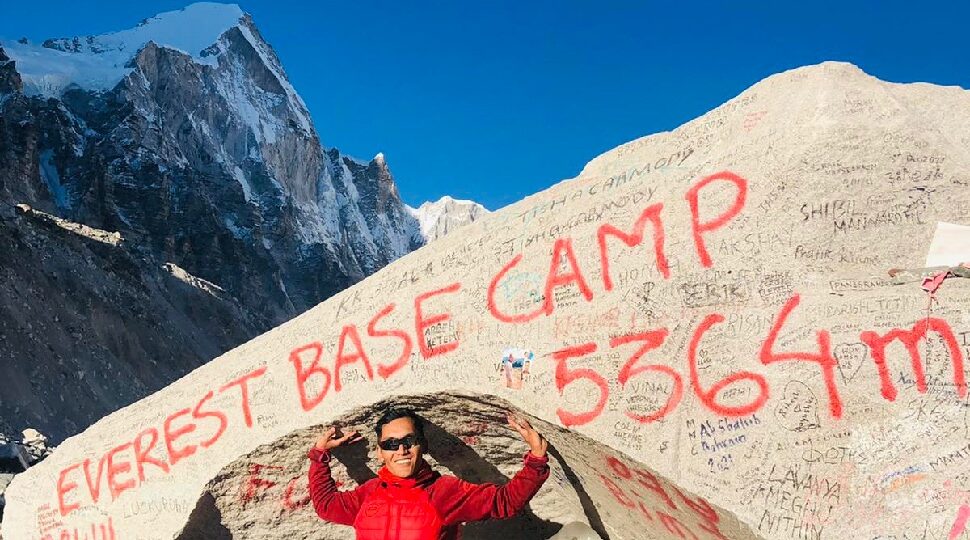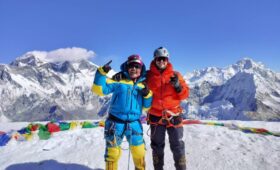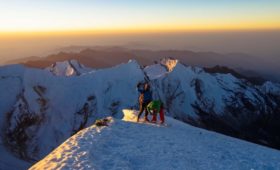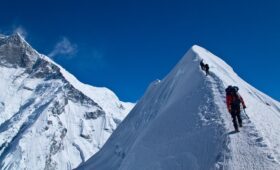March is the starting of spring, one of Nepal’s two high season. While temperatures in the high Himalayas are likely to be chilly. Hikers hit the trails in big number again in March, and there are several good reasons to do so. Here’s everything you need to know about hiking to Everest Base Camp in March.
Everest Base Camp Weather in March
Rain is uncommon in March, so clear mountain views in the Everest region is great. However, as temperature goes up throughout Nepal, especially the second half of the month, humidity rises. You’ll still get good clear views, but they won’t be as crisp or as reliable as they were in the winter.
The advantage is, of course, that March has warmer temperatures than January or February. While snow may remain at higher altitudes, and unexpected snowfall can break plans at any time, many trails will be thawing out by this time.
You should still prepare for chilly weather—temperatures in Namche Bazaar, for example, can drop below -3°C in the night. But they can also be as high as 12°C.
Everest Base Camp Trek: Crowds & Costs
While March isn’t as busy as April, guesthouses on the classic Everest Base Camp (EBC) route fills up quickly during this time. Trekking with a professional Sherpa guide is one way of preventing this, as they will book you into a decent lodge, although the options will be limited due to how busy the trails are.
Alternatively, you might choose an offshoot of the EBC trip that explores the same area but takes a less traveled route. Some ideas are given below.
Routes Recommendations
The classic Everest Base Camp trip is famous for a reason—but it is incredibly popular. There are numerous alternative routes in the Everest area that overlap with EBC but take you down quieter paths if you prefer quieter routes and views unobstructed by other trekkers’ heads.
Some of the more off-the-beaten-path camping expeditions are not recommended in March as temperatures at higher altitudes may still be cold, especially at night, and snow could be a concern. However, as March marks the start of the spring trekking season, many teahouses will reopen after their winter break, providing better accommodation choices than in January or February.
The Gokyo Ri trek diverges towards the blue waters of the trail’s nickname glacial lakes. The Tengboche Monastery trek leads you to one of Nepal’s most important Buddhist monasteries, from which you can see the spectacular Ama Dablam.
The Dingboche journey is similar but extends a little further to the little Dingboche village. The Ama Dablam Base Camp trek is also a great way to explore a place that many people seem to miss when trekking in this area.
Trekking peaks are usually accessible again in March, so if you want a more difficult challenge than a simple trip and have prior high-altitude climbing experience, a trekking peak is a suitable beginning to Himalayan climbing. Island Peak (20,305 feet/6,189 m) is a difficult but not too technical climb.
The journey to get there follows much of the classic EBC trek, so if this is your first time in the region, you can get the best of both worlds by following a popular route and going somewhere less visited.
What You Should Bring?
While the good teahouses normally provide blankets, it’s always a good idea to carry your own sleeping bag. Teahouse blankets aren’t washed very often, so they’re best used as a top layer, above your own cozy sleeping bag.
While a winter-weight sleeping bag will most likely be useful, they are quite bulky. Combining a three-season sleeping bag with teahouse woolen blankets should sufficient, as long as you also have appropriate clothing.
Down jackets are good because they are lightweight and easily packed away during the day if you get too warm while walking. Bring woolen hats, gloves, socks, and scarves, as well as good merino and synthetic fiber clothing to keep you warm in the evenings and nights.
Getting There and Away
Flying from Kathmandu to Lukla is the shortest way to reach the Everest region. Although rainfall is normally low in March, Kathmandu is especially smoggy and dusty in the run-up to the monsoon in June, which could cause flight delays.
Domestic flights between Kathmandu and Lukla will also fill up quickly in March, so book as far in advance as possible.
Know more how to get to the Lukla
If you’re looking for a longer adventure and wish to walk (nearly) the entire distance, take the trail from Jiri to Lukla. The ‘Pioneers’ Route’ was named after the trekking route that early Western mountaineers used to reach the Everest region before Lukla’s airport was built. Jiri is located approximately one day’s journey from Kathmandu.
Festivals and Events in March
The Everest region is mainly Tibetan Buddhist in culture and religion, and many of Nepal’s most interesting March festivals are based on Hindu traditions, so they are not widely celebrated in the mountains.
However, if you plan a trip in Nepal in March, you can join one of the following Kathmandu festivals before or after your trek. Traditional Nepali celebrations usually follow a lunar calendar, therefore certain events that fall in March one year may fall in February or April the next. Festivals that so often fall in March are:
Ghode Jatra is a Kathmandu-specific celebration during which the Nepal Army races horses at the parade ground (Tundhikhel) to ward off the demon Gurumapa.
Maha Shivaratri is especially vibrant at Kathmandu’s Pashupatinath Temple, where thousands of sadhus (Hindu holy men) gather to worship Lord Shiva.
Holi is a spring festival in which water and colorful powders are thrown around in celebration.
Our Top EBC itineraries in March
- Everest Panorama Trek – 11 Days
- Gokyo Ri Trek – 14 Days
- Everest Three Passes Trek – 16 Days
- Everest Base Camp and Climb Island Peak – 20 Days
More Useful Information
- Everest Base Camp in January
- Everest Base Camp in November
- Best Time to Time to Trek Everest Base Camp
- Nepal in April
Do you have any question about trip to Nepal?
Tell us about your trip to Nepal and what you expect from it. We will answer your questions in 24 hours and help you design a trip with a comfortable itinerary to best meet your needs.





